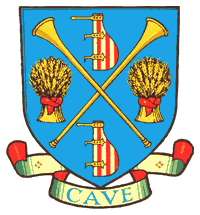Town History
5,000 – 10,000 years ago
“Ware is one of the oldest continuously occupied sites in Western Europe,” so wrote the archaeologist, Robert Kiln, in his book, ‘The Dawn of History in East Herts.’ He described how excavations on the GlaxoSmithKline site near Ware Lock had revealed settlements going back to the Mesolithic or Middle Stone Age of some 5,000-10,000 years ago.
The reason why people first settled here is due to Ware’s position on one of the country’s oldest roadways, at the point where it crosses the River Lea. The road later became known as Ermine Street and later still the Old North Road, which was the main road of medieval England. The stone implements of these prehistoric Ware citizens can be seen in the Ware Museum, along with a clay pot of the Bronze Age.
The Romans
 When the Romans came, they paved and widened Ermine Street to form a military road for the legions marching northwards, and a small town grew up along the road. It was probably also an inland port and one of the more grisly exports from here may have been slaves, since a Roman slave shackle (now in the Ware Museum) was found near Ware Lock. A number of buildings have been found on the GlaxoSmithKline site, including pottery kilns, and finds have included jewellery and ladies’ toilet implements, like eyebrow tweezers.
When the Romans came, they paved and widened Ermine Street to form a military road for the legions marching northwards, and a small town grew up along the road. It was probably also an inland port and one of the more grisly exports from here may have been slaves, since a Roman slave shackle (now in the Ware Museum) was found near Ware Lock. A number of buildings have been found on the GlaxoSmithKline site, including pottery kilns, and finds have included jewellery and ladies’ toilet implements, like eyebrow tweezers.
It must have been a substantial town, from the large number of burials which have been discovered around the edges of the Roman site. It is these burials which are undoubtedly the reason why, during the 16th century, the GlaxoSmithKline site became known as the Buryfield (long before the Great Plague of 1665, which is sometimes thought to be the reason for the name).
The Anglo-Saxons
After the Romans came the Anglo-Saxon invaders and examples of early Saxon pottery were found during the extension of the Library in the High Street in 1977. One rare and intriguing find is a Saxon coin of the 7th century AD which came to light just north of the High Street – it is also in the Ware Museum.
It is towards the end of the Saxon period that the story of Ware’s early history really takes off. In the 9th century, a large Danish force had overrun the Saxon kingdoms of Northumbria, Mercia and East Anglia, until only Wessex was left. The Peace of Wedmore in 886 established a frontier between Wessex and the Danelaw. Part of this frontier was the River Lea, and Ware found itself a frontier town; it is thought that two Ware place-names, Wengeo and Widbury, are of Danish origin.
The ‘Anglo-Saxon Chronicle’ records that, in 895, the Danes moved a large force along the Thames and up the River Lea for 20 miles, where they established a fortification. King Alfred came up the river with an army of Londoners and tried to engage the Danes in battle but was beaten off. So Alfred, using the Danes’ own tactics, built fortifications on either side of the river and started work on diverting the river’s course so that the Danes could not row their ships down the Lea again to the Thames. Then the Danes decamped and marched across country to the River Severn. Most archaeologists now believe that this happened at Ware, and the town’s Saxon name ‘Waras’ comes from the weirs Alfred built.
One result of the Danish wars was the building of Hertford as a Saxon fortified burg, and for a while Ware appears to have been controlled by the authorities in Hertford. However, the Domesday Book records that in the later Saxon period, under King Edward the Confessor, Ware was still a substantial settlement with a large population, five mills, and worth more in taxes than Hertford.
Hugh de Grentmaisnil
After the Norman Conquest, Ware regained its independence and began to grow. The first step was taken by Hugh de Grentmaisnil, the lord of the manor recorded in the Domesday Book, who obtained a charter in 1078 to found a priory, as a daughter house of his family’s Abbey of St Evroul in Normandy. This priory was established to the north of the High Street, in the area of St Mary’s Church, and suppressed by King Henry V in 1414 – it is not to be confused with the Franciscan friary south of the High Street, which is now known, rather confusingly, as ‘The Priory’. Hugh and his immediate descendants rebelled against the King, with the result that their estates in Ware were forfeited to the Crown.
The manor of Ware was eventually restored to Hugh’s great-granddaughter, Petronil or Parnel, who was married to Robert Beaumont, Earl of Leicester. It was Petronil and her son, Robert, who at the end of the 12th century laid out the town centre as we know it. Using the priory as a sort of pivot, they diverted the course of the old road so that it ran parallel with the river for about half a mile and then crossed the Lea at a new bridge, much farther to the east than the old one.
The new High Street they created was wide enough to accommodate a market, shops and a fair. An added bonus was that a number of attractive ‘burgage plots’ were created between the road and the river, designed to be sold or let to burghers, or free merchants. The new town layout and diversion of the old road were given official recognition during a visit by Henry III, who declared that the new bridge formed part of the King’s Highway. Royal charters for a market and an annual fair were granted at about the same time, as well as a charter for the tolls of all ships going down to London from Ware Bridge and all vehicles crossing the bridge.
However, the new arrangements did not pass without opposition. One of the records of the time states that ‘the bailiff and men of Ware have turned aside the way that used to pass by Hertford to Ware to the detriment of the town of Hertford’. Official recognition or not, Hertford could not let this pass, and its bailiffs acted by putting a chain across the new Ware bridge. This happened when Sayer de Quincey, Petronil’s son-in-law, was lord of the manor. The story has it that Sayer broke the chain and threw it into the river, telling the bailiffs that they would follow if they tried to repeat the exercise. Since Sayer de Quincey was Earl of Winchester and one of the barons who made King John sign the Magna Carta, the men of Hertford did not repeat the exercise, but Hertford went on grumbling for many years afterwards about Ware’s new prosperity.
Ware was situated on the Old North Road, the main thoroughfare of medieval and Tudor England from London to York and Scotland. In the centuries following the Norman Conquest, the main traffic on this road was military, but in about 1400, the people themselves began to move more freely around England, either for trade or on that medieval equivalent of tourism, the pilgrimage. Ware is mentioned in the most famous account of a pilgrimage, Chaucer’s ‘Canterbury Tales’, as being the town from which the cook originated, and Ware was itself on the other main pilgrimage route, to the shrine of the Virgin Mary at Walsingham in Norfolk. One Tudor writer said that the road through the town was known as ‘Walsingham Way’.
To serve these pilgrims and travellers, virtually every building in Water Row (the south side of the High Street) was an inn at some time during the period from 1400-1700. There were other inns in Land Row and Baldock Street, as well as a few in Amwell End, but it was the inns of Water Row that were ‘great and sumptuous hostelries’, as described by Raphael Holinshed. The most important were the Crown, the White Hart, the Christopher, the Bull, the George and the Saracen’s Head. The inns have long since been converted into shops, but the waggonways, which are a feature of the High Street, remain as reminders of the great inns of the past. No wonder the Tudor poet, William Vallens, described his home town as ‘the guested town of Ware’.
Malting
What led to the disappearance of the inns was another thriving Ware industry, malting. The passage of wagons bringing barley into the town for malting made the roads almost impassable for much of the winter, with the result that, in 1663, England’s first turnpike was set up at Wadesmill, in an attempt to control the malting traffic. Immediately, travellers began to find alternative routes. Before 1663, Samuel Pepys travelled to Cambridge by way of Ware – often complaining about the state of the road, particularly when he had to get down from the coach and fell into a ditch – but after the erection of the turnpike, he preferred to go via Bishop’s Stortford. Others went by way of Hatfield, on what became known as the Great North Road.
In an attempt to attract what was left of the coaching business, the Ware innkeepers offered new facilities. Riverside gardens were laid out with summerhouses, or gazebos, for the enjoyment of their guests. In addition, any visitor who wished to stay in an inn containing the Great Bed of Ware was treated to an elaborate and bawdy ritual. In their time, a number of Ware inns housed the Great Bed, which is now in the Victoria and Albert Museum, London. It is thought to have been made as a sort of advertising gimmick for the Ware inns.
The malting industry dominated the life of the town from the 17th century, and Ware could justly claim to be the premier malting town in England. What gave malting in Ware the edge over other centres was its position between London and the barley-growing counties of Suffolk and Cambridgeshire, and also its situation on the River Lea with easy transport by barge to London. One of Ware’s specialities in the early years was brown malt – a malt which had been cured at a high temperature over a wood-burning kiln – and this became the main ingredient of ‘porter’ or ‘entire’, the main drink of London’s labourers during the 18th century. Brown malt earned Ware its superiority and its own quoted price on the London Corn Exchange. There are many former malthouses in the town, now converted to other uses, and the last working malting, Paul’s at Broadmeads, was a thoroughly modern, computerised plant. However, that too closed, in January 1994, thus bringing to an end the 600-year-old malting industry for which Ware was once famous.
The Present and the Future
The malting industry has gone, and many of the old maltings have been converted into offices, factories and residential units, but Ware still retains its industrial character. The main employer is now GlaxoSmithKline which continues to manufacture its world-famous drugs on the site first occupied by Allen and Hanburys in 1899. As well as the manufacturing site, GlaxoSmithKline also has a large modern research establishment nearby. The town’s other industries are located on the other side of the town in Crane Mead, Marsh Lane and Broadmeads.
Ware’s historic assets in the road and the river still continue to flourish, even though the main A10 traffic travelling between London and Cambridge now uses the bypass which runs on a viaduct across the Meads. The River Lea no longer carries commercial barges but is well used by pleasure craft of every description and is very popular with anglers. On the north bank of the Lea, many of the gazebos have been restored and are now seen as one of the town’s unique attractions.
Ware is a busy commercial town but proud of its heritage. Many of the older buildings are listed, and the town is designated a centre of ‘outstanding archeological and historical interest’. In recent years, Ware has begun to attract tourists and guided tours of the town centre are held on some Sundays in the summer months. There are also regular Summer band concerts in the Priory grounds, as well as the opening of the Museum on Tuesday, Thursday, Saturdays and Sundays. However, Ware does not live in the past. At the start of a new Millennium, Ware is a bustling town, with large science-based industries and many small businesses, with nine churches and eleven schools, with many voluntary organisations and, above all, a thriving community spirit.
Armorial Bearings of the Ware Town Council
 By letters patent in 1956 the College of Arms granted Armorial Bearings to the Ware Urban District Council.
By letters patent in 1956 the College of Arms granted Armorial Bearings to the Ware Urban District Council.
On the 16th April 1975 Her Majesty The Queen was graciously pleased to make an order in Council (to be effective on May 19th 1975) whereby the Armorial Bearings of the Ware Urban District Council were to be transferred to the Ware Town Council.
The details of the coat of arms are as follows:
- The blue field of the shield alludes to the river.
- The barge rudders, striped with the livery colours of the City of London (red), refer to the free entry of the Ware bargemen to the Port of London.
- The sheaves of barley (gold) refer to malting.
- The post horns (gold) to the town’s coaching inns.
- The motto “cave” meaning “beware” was suggested by the College of Heralds and intended as yet another pun on the Town’s name.
